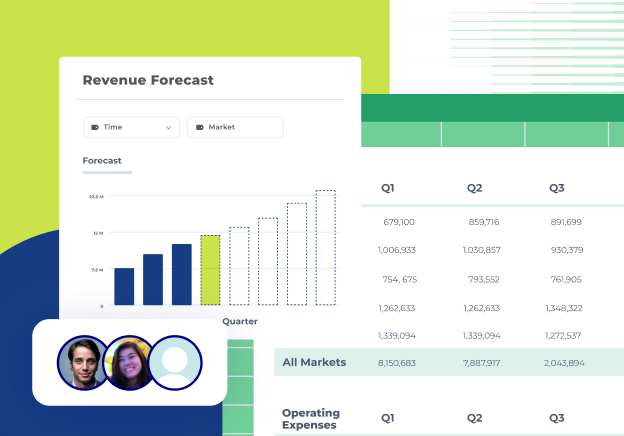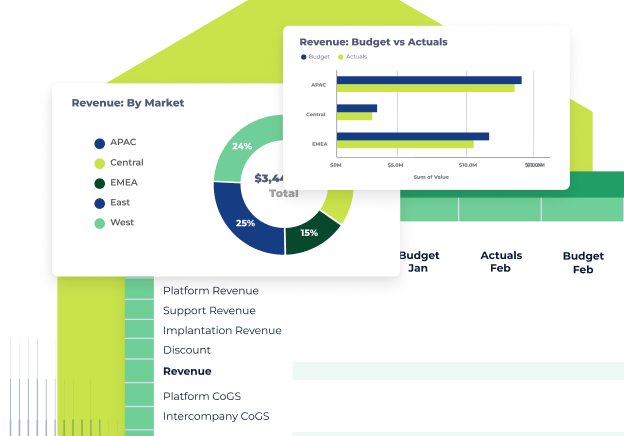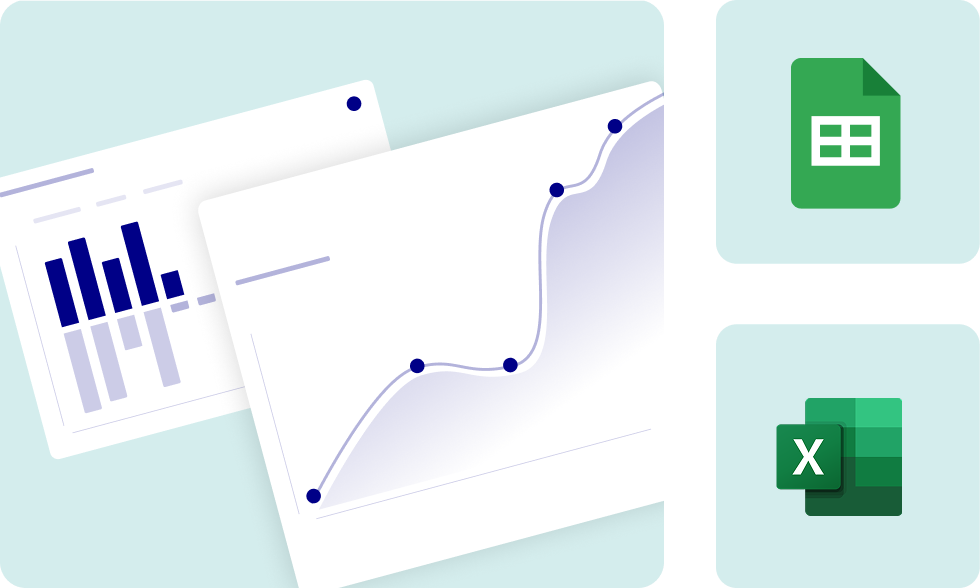What's inside this rolling forecast Excel template
This template helps organize your Rolling Forecast for your OpEx Spending.
You can download the monthly actuals from your ERP and copy those into the actualized periods in the template. You may also input the actuals into this template and pull in the summarized data via spreadsheet formulas (SUMIFs, VLOOKUP's, etc.).
Next, you can pull in, enter, or update formulas to calculate your forecast figures. There's a "Latest Closed Month" filter on each tab to update the time horizon you are planning for.
This model has eight components:
- Department variances: Find where department expenses differ from budgeted amounts.
- OpEx variances: Identify gaps between your actual operating expenses and what you budgeted for.
- Steps: Organize the actions taken to keep your forecast updated.
- OpEx plan: Create a blueprint for anticipated operating expenses over a set period.
- Headcount analysis: Track how many employees you have compared to your planned number of employees.
- Sales & marketing: Predict and assess sales and marketing expenses.
- T&E: Monitor travel and entertainment expenses associated with business activities.
- Drivers: Keep tabs on the key factors that impact your company’s financial health.
Use this rolling forecast template with Cube
This is an Excel template. You don't need to be a Cube customer to use it!
But if you are a Cube user, you can start using this template in under two minutes. Here's how.
Step 1: Open the template in Excel or Sheets.
Step 2: Customize the row and column headers to match your Cube's dimensions and filters.
Step 3: Select the range where you want to fetch your data.
Step 4: Fetch your data.
.gif?width=600&name=CreateTemplate%20(1).gif)
All about rolling 12-month forecasts
The rolling 12-month forecast always forecasts 12 months into the future. Whenever you close a month, you add another month to your rolling 12-month forecast. This means you're always planning and predicting future performance based on actual performance.
Unlike a traditional forecast, the rolling 12-month forecast is never more than a month out of date. Using a rolling forecast allows you to always have a plan for a set time period that is continuously updated based on the latest period of actuals.
So the rolling 12-month forecast makes you a more nimble planner. You're better able to react to what's happening in your organization right now.
Rolling forecasts vs. static budgets
Rolling forecasts and static budgets each have their own strengths. Rolling forecasts are all about flexibility and staying up-to-date with the latest data. They let you adapt quickly to changes, making them perfect for dynamic environments. On the other hand, static budgets are set in stone for a specific period, which can help maintain control and discipline.
When do you choose one over the other? If your business needs to respond fast to market shifts, rolling forecasts are the way to go. But if stability is more your company’s speed, a static budget might be the better fit. Consider your business goals and environment to decide which approach serves you best.
How to make a 12-month forecast
Creating a rolling 12-month forecast involves several strategic steps. Here’s how to make and maintain a rolling forecast template for your business:
1. Gather accurate and current data
Effective rolling forecasts depend on robust data collection from both internal and external sources. Start with your completed budget as the foundation, then layer in actual financial figures from your financial reporting dashboards for each closed period. Internal data should include departmental performance metrics, sales pipelines, and operational KPIs that reveal business patterns.
Complement this with external market intelligence—industry benchmarks, economic indicators, and competitive analysis—to provide crucial context. This dual approach helps you anticipate market shifts while maintaining financial accuracy.
Before incorporating any data point, validate its reliability through cross-verification and assess its historical predictive accuracy. This ensures your rolling forecast remains both relevant and trustworthy, significantly reducing the risk of misguided financial decisions.
2. Define your objectives
Establishing an end goal and objectives for your company is key to a successful rolling forecast. They’re what dictate the direction your forecast takes, including which metrics you’ll track. Define what you’re forecasting, who will use the forecast, and what decisions it will inform.
Example objectives you might establish for your rolling forecast include:
- Improving cash flow management by projecting monthly runway and identifying potential cash gaps 90 days in advance
- Enhancing budgeting accuracy through monthly variance analysis with less than 5% deviation from actuals
- Supporting strategic planning by quantifying the financial impact of new market expansions or product launches
- Adjusting operational strategies based on real-time cost trends to maintain target gross margins within your goals
3. Customize the rolling forecast template in Excel or Sheets to match your Cube's dimensions and filters
Once you’ve chosen and downloaded your free FP&A Excel template, open it in Excel or Google Sheets to start customizing it.
If you’re a Cube user, the next step is to push and pull your data stored in the Cube cloud. To make it happen, customize the row and column headers of your spreadsheet so they match your Cube’s dimensions and filters exactly. This creates a delivery system between your data and the rolling forecast template.
4. Select the range where you want to fetch your data
A range is the designated rows and columns that tell Cube what data to retrieve and how to display it. It uses your dimension names to connect your spreadsheet data to your data in the cloud. You can use any type of dimension member in your range, including tags, formulas, and attributes. Cube will recognize them so long as their names match exactly.
5. Utilize forecasting software
Forecasting and budgeting software automates data collection and consolidation, eliminating manual work and providing real-time insights so companies can strategize with speed and agility. AI forecasting tools, in particular, uncover hidden patterns and flag anomalies that usually escape even the most diligent human analysis.
For rolling forecasts specifically, the forecasting software can incorporate your most recent actuals and preserve previous forecast versions for variance analysis. It transforms financial planning from a backward-looking compliance exercise into a forward-thinking competitive advantage that drives better business decisions.
6. Identify which stakeholders will be involved
Involve various departments in the forecasting process to gain diverse insights—including non-financial executives. Typically, finance, sales, operations, and marketing play crucial roles in contributing to a well-rounded forecast. To choose which stakeholders will provide the most valuable perspectives and data, use your objectives as the ultimate deciding factor.
7. Pick the most important metrics to hone in on
Identify key operational metrics that directly influence your company’s chosen end goal and objectives, and track them within your rolling forecast template. Any changes to these metrics can be used to analyze how your finances are being impacted so you can adjust course accordingly.
Some example metrics your business might want to track include:
- Runway: The amount of time your company can continue at its current spending rate before it runs out of cash.
- Average revenue per account: The average revenue generated from each customer account over a specific period.
- Burn rate: How quickly your company is using up its available capital.
- Churn rate: The rate at which customers cancel their subscription or stop using your company’s service.
- Gross margin: The percentage of revenue your company retains after deducting the direct costs of producing your product or service.
- Customer acquisition cost: The total cost your company incurs to gain a new customer.
8. Fetch your data
Your rolling forecast template can’t give you on-point financial calculations and predictions if the data being used is unreliable or outdated. Always make sure your data is accurate and up-to-date before fetching. Once you’ve confirmed your data is good to go, import it to your spreadsheet.
9. Compare the date between actual and estimated
Make sure your finance team reviews variances between projected and actual numbers. Tracking actual performance and comparing it to the forecasted data helps leadership understand which targets were met or missed—and why.
This intel is helpful for making more reliable projections for the next round of financial forecasting models.
10. Update the forecast
The defining quality of a rolling forecast is that it can be reviewed and adjusted regularly based on current market conditions. Updating your forecast on a monthly basis will reflect the latest data and market changes so you can help you quickly determine if you need to reallocate company resources to keep your goals on track.
Regular updates ensure your forecasts remain relevant and accurate so your company can stay agile and responsive to new information.
11. Use your data for decision-making
When your company exists in an ever-evolving landscape, rolling forecasts can help you better prepare for market shifts. They allow you to quickly adjust spending in response to current market data, helping you stay ahead of the curve while navigating economic changes. Rolling forecasts also give leadership the data necessary for identifying areas that need attention and tending to them before serious problems crop up.
Benefits of rolling forecasts
Rolling forecasts offer several advantages for businesses, transforming how they plan and adapt to changing conditions. These benefits include:
- Adaptability to market changes: Ensures financial strategies are continuously relevant and responsive to economic shifts.
- Enhanced accuracy: Provides more accurate and timely financial projections, reflecting current market realities.
- Proactive decision making: Enhances the ability to anticipate and prepare for future financial scenarios, leading to more strategic budgeting and responsive planning.
- Forward-looking approach: Encourages a shift in focus towards future planning rather than relying solely on past performance.
- Agility in uncertain environments: Offers crucial flexibility in rapidly evolving economic conditions, enabling swift adaptation to unforeseen changes and market volatility.
- Continuous improvement: Enables ongoing refinement and fine-tuning of financial strategies, ensuring they evolve and improve over time.
Grab Your Free Template
Our free Rolling 12-Month Forecast template for Excel is designed to enhance your financial forecasting with accuracy and efficiency.
Get started today by entering your business email to begin your download.
Rolling forecast FAQs
What's the difference between a rolling forecast and an annual budget?
The two biggest differences between a rolling forecast and an annual budget are flexibility and update frequency. A rolling forecast is continually updated, offering a flexible approach that adjusts to real-time changes and market conditions.
In contrast, the annual budgeting process involves a fixed financial plan set for a fiscal year. It provides a static framework to guide spending and revenue expectations.
How does a rolling forecast template assist in operating expense forecasting?
A rolling forecast template acts as a jumping off point for better navigating the ever-changing landscape of operating expenses. Even a simple rolling forecast template empowers you to identify trends, react quickly to changes, and make informed decisions that keep your expenses in check. This means greater accuracy in expense forecasting and a more agile approach to financial management.
What are the challenges of using a rolling forecast?
Using a rolling forecast demands a consistent flow of accurate and up-to-date data. It also requires a commitment to regular updates and a willingness to adapt quickly. Fortunately, the benefits that come from being able to pivot and respond dynamically to business needs usually outweigh these challenges.
Why is a rolling forecast template important?
A rolling forecast template makes it easy to identify trends, react quickly to market changes, and make informed decisions that keep your expenses in check. Rolling forecasts ensure your plans are always aligned with your business’s strategic goals.



.png)









.png)
